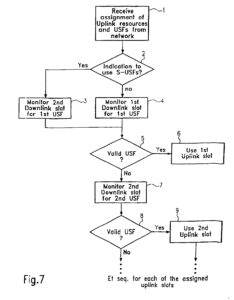Mentone Solutions LLC v Digi International, Federal Circuit 2021 (Software Patents)

Characterization of an invention must reflect the claimed invention at an appropriate level of abstraction, for an Alice analysis.
U.S. Patent No. 6, 952,413 relates to resource allocation in general packet radio systems. In those systems, a number of mobile stations communicate with a single network through physical links called Packet Data Channels. When the mobile stations receive information from the network, they are engaging in downlink (DL) communication, and when
the mobile stations are transmitting information to the network, they are engaging in uplink (UL) communication. These mobile stations communicate within time frames, each divided into eight timeslots. To control access to the Packet Data Channels, which are shared among mobile stations, the network uses an uplink status flag (USF). That flag can take eight values, 0 through 7, allowing allocation of resources for up to eight mobile stations. According to the patent, to most effectively utilize the available bandwidth, access to packet data channels may be dynamically allocated. The amounts of time that the mobile station receives downlink or transmits uplink may be varied and
slots allocated accordingly. In systems using an extended dynamic allocation method, there is a fixed relationship between the downlink slot in which a valid USF is received and the uplink slot in which transmission begins; a mobile station’s receipt of a valid USF in a certain downlink timeslot indicates the availability for that station to begin transmission in the corresponding uplink slot. The patent allows a mobile station access to previously restricted multislot configurations through “altering the fixed relationship in the timing of the downlink allocation signalling and subsequent uplink transmission for certain classes of mobile station.” For example, it purports to allow configurations that would otherwise be impossible due to insufficient
turnaround time.
Claim 5 is representative and recites:
5. A multiple access communication method in a mobile station, comprising the steps of:
- receiving an assignment of at least a first PDCH (packet data channel) and a second
PDCH; - monitoring an assigned PDCH to detect a USF; and
- transmitting on an assigned PDCH corresponding to the USF, wherein (i) if shifted USF operation is not
used then a first assigned PDCH is monitored to detect a USF corresponding to the first assigned PDCH and (ii) if the shifted USF operation is used then a second assigned PDCH is monitored to detect the USF corresponding to the first assigned PDCH and a USF corresponding to the second assigned PDCH.
The district court held that claim 5 is patent ineligible, directed to the abstract idea of receiving a USF and transmitting data during the appropriate timeslots. It further held that the shifted uplink status flag combined with the abstract idea, functional limitations, and anything else is not significantly more than a claim to the abstract idea.
Considering the problems and solutions discussed in the specification of the patent, the Federal Circuit took the position that claim 5 is directed to a patent-eligible improvement to computer functionality, namely permitting additional multislot configurations for certain classes of mobile stations using extended bandwidth allocation. It adds this capability through using a shifted USF that breaks the fixed relationship in the timing of downlink allocation signaling (i.e., receipt of a USF on a timeslot) and subsequent uplink transmission. The specification shows how
using the shifted USF, as in Figure 4, allows a mobile station to utilize the otherwise impermissible configuration of
Figure 3 because the mobile station has sufficient turnaround time to switch from a receive condition to a
transmit condition. And this newly allowed multislot configuration provides an additional uplink slot. Like the claims the Federal Circuit held patent eligible in DDR Holdings, LLC v. Hotels.com, claim 5 improves
the normal operation of the communication system itself to “overcome a problem specifically arising in the realm of
computer networks.”
The Federal Circuit stated that the specification also provides important details on the technological problem and how the claimed invention solves that problem. The specification is of particular importance here, as “shifted USF” appears to be a coined term by the inventor. Here, there is no functional claiming, nor are there abstract
steps.
The district court held that claim 5 was directed to the abstract idea of “receiving a USF and transmitting data
during the appropriate timeslots.” The Federal Circuit did not agree. The district court’s formulation of the abstract idea appears to be a high-level description of how USFs operate in mobile stations using extended bandwidth allocation generally. However, the claimed invention departs from this conventional use through a
shifted USF, which breaks the fixed relationship between USFs in a downlink slot and the availability for transmission in the corresponding uplink slot. The district court’s abstract idea fails to mention a shifted USF, nor does it capture the receipt of two PDCH assignments that permit monitoring and detecting the PDCHs for a shifted USF and
transmission based thereon. Accordingly, it is untethered to the invention as claimed.
The Federal Circuit found the claims to be patent eligible under Alice step one.
A problem with all Alice analyses is how high of a level of abstraction to apply. Everything can be found to be abstract at a high level, if detail found in the claim is ignored. Discussing a problem and solution in detail in the specification seems to have helped the patentee in this case.